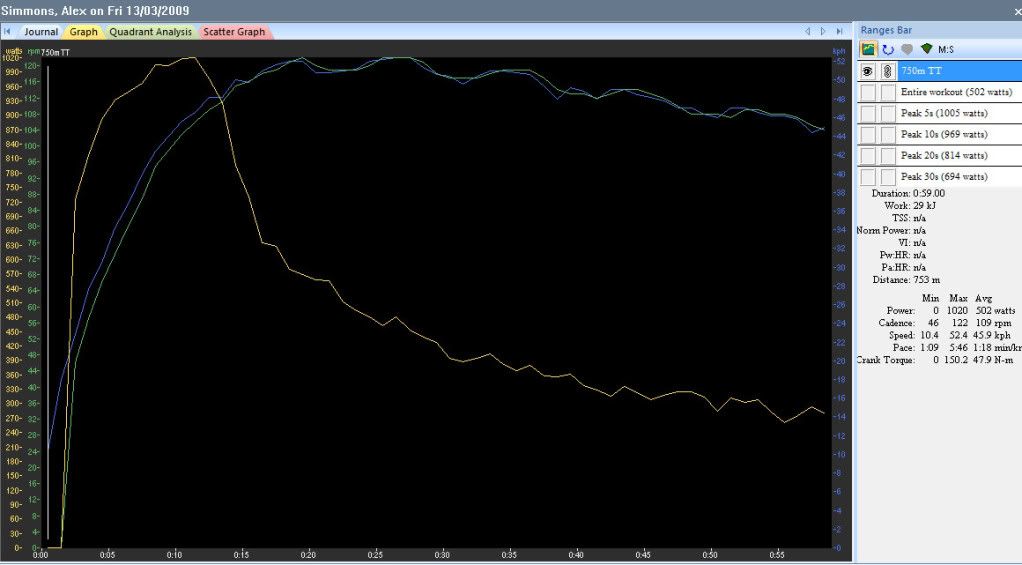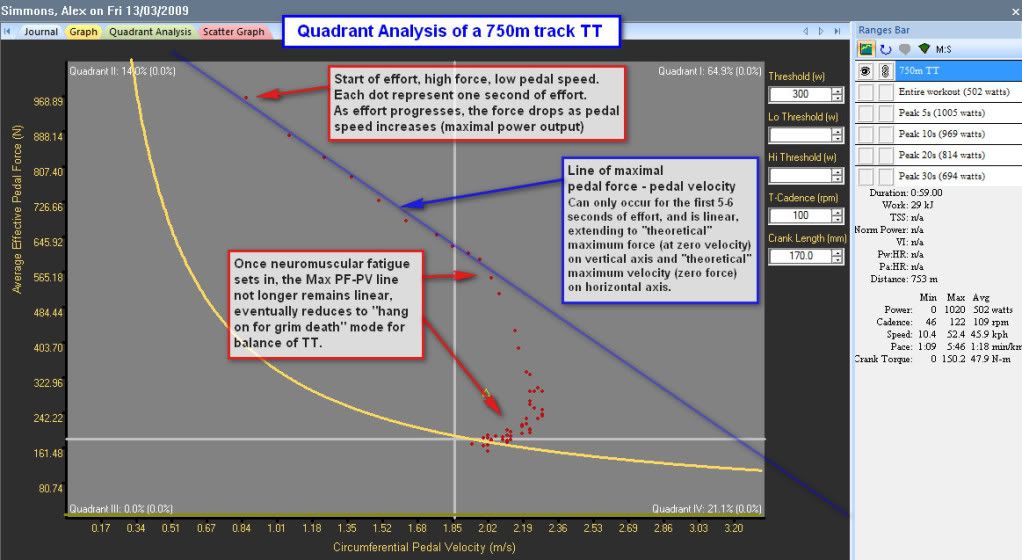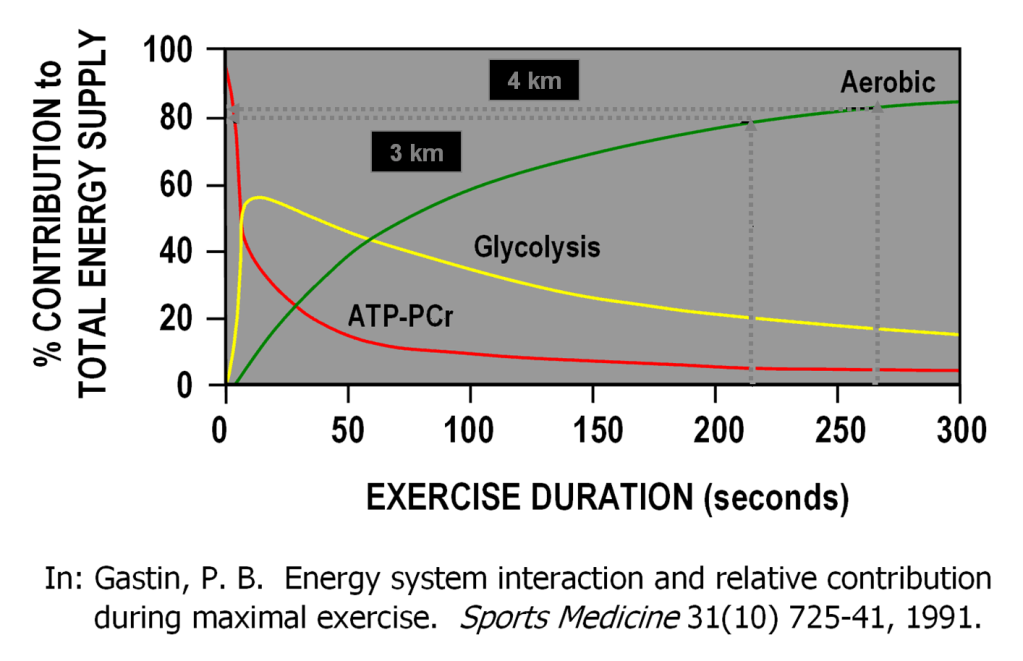Building muscle - how best to, and the pros and cons
Comments
-
OP, Back on topic.
If you do want some advise please PM me, I used to be a very serious bodybuilder (check out my photos on Muscletalk, name is "Squill") as I dont think this thread is going where you want.
But, as already said, a stone in 2/3 months (of LMM) can only be done with ped's. Though I have all my old trainign plans, my journal is also on MT, showing my prep for comp etc.0 -
I'll tackle this in two parts.SteveR_100Milers wrote:Alex, out of interest, what do the AEPF and power plots look like for say the kilo?
1. QA and AEPF
2. Aerobic/anaerobic energy contribution.
1. Quadrant Analysis and AEPF for a track TT
I'm not at liberty to share client data, however this example from a 750m track TT I did in 2009 illustrates what they look like, only the absolute numbers change, although a specialist TT rider would not fade quite as much as I do in the latter stages. Here is the regular power plot most with a power meter would be familiar with:
Due to riding with a prosthetic leg, my peak power doesn't go so high any more as it did pre-amputation and I hang onto what max power I have a bit longer, so my apparent point of neuromuscular fatigue occurs a fraction later than is typical (usually 5-8 seconds). I am getting better though, with peaks now approaching 1200W.
The QA of this data reveals quite a lot of interesting stuff. I have annotated in the picture below.
Essentially each dot represents 1-second of power data* (although best with 0.5 second recording), plotting the pedal force (vertical axis) in Newtons and pedal velocity (horizontal axis) in metres per second. Cadence isn't used since crank length can vary, so pedal velocity normalises such analysis.
The effort starts at top left (high force - low velocity) and progresses down and to the right as speed increases, force drops (it has to - it's a physiological requirement).
You will note that the very start of the effort the PF-PV plot is linear, until neuromuscular fatigue sets in after 6-8 seconds, at which point we then rely on our regular energy systems to power (grovel) our way home.
The curved yellow line represents PF-PV at 300 watts. The quadrants are arbitrarily delineated using a centre point on 300W at 100rpm. When you look at that line, you can compare how far away riding at threshold levels are from our maximal force-velocity line.
Strength by the way, as I regularly remind people, is defined (in exercise physiology) as the maximal force generation capacity of a muscle or group of muscles. By definition it can only occur at zero velocity. IOW, once we start pedaling, we can no longer apply our maximal force, and the role of strength diminishes somewhat, even for a track TT rider.
Indeed, even for a specialist track TT rider, only so much strength is of use and more than "enough" may end up making you slower, not faster. That's why training (should) focus on power delivery at the event specific pedal speeds, rather than getting stronger (unless your basic strength level is inadequate for the task).
Stronger does not necessarily equal faster. More powerful (per kg) equals faster and power is force and speed and focusing on one without the other does not do the trick I'm afraid. In other words, training at each end of the max PF-PV line won't have an impact at the pedal forces/velocities that matter.
2. Energy Systems - Aerobic v anaerobic
As for the relative contribution of aerobic and anaerobic energy sources, this can be assessed by examining the cumulative O2 deficit which can be plotted from power meter data, all one needs is a rider's VO2max (or data from a well paced 3km-4km maximal pursuit effort).
See this post on Maximal Accumulated Oxygen Deficit (MAOD) used to assess team pursuit data, which I penned along with Andy Coggan:
http://alex-cycle.blogspot.com/2007/02/ ... rsuit.html
The same principle could be used for a track TT, although there is a chance that a rider has not fully depleted their anaerobic work capacity (joules) in such a short time. Since I have not examined such MAOD from the same rider doing both a pursuit and a kilo (since one rider doing both events is relatively rare and a pursuit is long enough for AWC to be depleted for comparison), then I can't say for certain.
Kilo TTs still have a substantial aerobic component. 40%-50% of energy supplied via aerobic metabolism would be typical. This can be seen in the following chart by Gastin showing the relative contribution of the three main energy systems in play for maximal efforts up to 5-min duration.
* BTW such analysis of track starts and max PF-PV can only be done with an SRM power meter. Other meters have characteristics that makes them unsuitable for such analysis.0 -
FWIW (not a lot I suspect), much of what you're saying, Alex, is exactly what I've been saying (albeit mine was both less eloquent and without the jargon). Force is ALWAYS harder to apply to something moving (it's why power is such a useful measure) - it's exactly the same in the combustion chamber of a car - the piston receding from the flame front (and why peak torque for a diesel is 1500rpm and peak power around 4500rpm).
I could go through your post and annotate just about every point with where and how I've agreed with you.
And, FWIW (hopefully a bit more) what you're doing is really interesting and really appeals to me as both an engineer and a medical engineering practitioner. I also spend a lot of time analysing my motor racing data (I even measured my HR which hit a rather frightening 183bpm as I was chasing down another car whose tyres were going off on the last lap) to see what works and how I can improve me and the car.ROAD < Scott Foil HMX Di2, Volagi Liscio Di2, Jamis Renegade Elite Di2, Cube Reaction Race > ROUGH0 -
I'm sure that Chris Hoy is strong. But even Chris Hoy knows that only so much strength is useful and too much muscle bulk will make him slower (he has said as much himself). Hence his main focus in training is developing power, not strength. He would do strength work in phases as necessary to get to a certain level. After that it would be as much maintenance as necessary.meanredspider wrote:Which, to be fair, is why I've kept dragging this back to Chris Hoy - a "strong" cyclist I'd have thought in everybody's definition (he looks like he could kick a door or two in)? He's strong and produces huges amounts of power. He also happens to be one of our most successful cyclists. What I was seeking to do was point out, in layman's terms, that strength IS key a component of power.
As an example of strength vs power, as a masters age track enduro rider pre-amputation, I could readily out squat dual Olympic sprint and Keiren champion Ryan Bayley. By some margin, in fact his 1RM squat was quite modest. I was stronger. Yet he could do a 200m fly 3 seconds faster than ever I could. He is way way more powerful.
For a world class elite track sprinter/TTr, then around 2 to 2.5 x body mass free squat is more than sufficient strength for these events. Developing more is a waste and possibly detrimental.0 -
Let us know which bits you don't understand and we can work through it.CarbonCopy wrote:This is great but i don`t understand all these big words. Alex does seem very very educated in the subject and it`s a pleasure learning from his posts.i also enjoy reading other peaples opinions too.like i said this is great
Alex does seem very very educated in the subject and it`s a pleasure learning from his posts.i also enjoy reading other peaples opinions too.like i said this is great 
It might be thread drift, but so what if people learn some interesting stuff. That's the interweb for you. 0
0 -
Cheers Alex
After reading through this all again along with many other training threads i was wondering if it could be possible to do a sticky thread at the top of the training forum regarding all the abbreviated words like FTP and so on.There are lots of these used and some of us don`t truly understand them.So if someone has the time and the knoledge please try and sort something.0 -
I would second that, would be great to read through0
-
If anyone who knows a lot (my knowledge will be woefully short) would be prepared to do this, we'll happily sticky it as a jargon guide for new riders.CarbonCopy wrote:Cheers Alex
After reading through this all again along with many other training threads i was wondering if it could be possible to do a sticky thread at the top of the training forum regarding all the abbreviated words like FTP and so on.There are lots of these used and some of us don`t truly understand them.So if someone has the time and the knoledge please try and sort something.0 -
How about this list on Cycling Forums?whyamihere wrote:
If anyone who knows a lot (my knowledge will be woefully short) would be prepared to do this, we'll happily sticky it as a jargon guide for new riders.CarbonCopy wrote:Cheers Alex
After reading through this all again along with many other training threads i was wondering if it could be possible to do a sticky thread at the top of the training forum regarding all the abbreviated words like FTP and so on.There are lots of these used and some of us don`t truly understand them.So if someone has the time and the knoledge please try and sort something.
http://www.cyclingforums.com/forum/thre ... st_39235720 -
Cheers, I've sent a message to the poster asking permission to use what he wrote.0
-
Thanks fo for that Alex.....Would it be ok to copy and paste that to this site ?0
-
Alex, thanks for your reply. In very simple terms, I guess I am going to benefit by doing dynamic squats rather than stationary squats.
Out of interest, what, if any is the different metabolic process between static muscular "work" and dynamic work? Also, is there a difference in the process and function (and therefore training) between fast and slow twitch? Does it really matter that there is a difference, as in your are born with whatever mix you have that will either make you naturally better at one or another type of event?0 -
Alex_Simmons/RST wrote:I'm sure that Chris Hoy is strong. But even Chris Hoy knows that only so much strength is useful and too much muscle bulk will make him slower (he has said as much himself). Hence his main focus in training is developing power, not strength. He would do strength work in phases as necessary to get to a certain level. After that it would be as much maintenance as necessary.
Absolutely - as I say, I've agreed with you in my earlier posts - see my example of the World's Strongest Man vs Usain Bolt - you need to work on both elements of power - strength and speed of delivery (pedal force and pedal velocity in cycling terms). At no point have I said strength is the only factor in power production.
Power is also derived rather than directly measured.ROAD < Scott Foil HMX Di2, Volagi Liscio Di2, Jamis Renegade Elite Di2, Cube Reaction Race > ROUGH0 -
Hi there.
I started hitting the gym in september 2001. I weighed in at a measly 10 stone but i am 6ft 2 inch. I was that embarrassed with my physique or should i say lack of it , that i installed a multi gym combined with free weights in my bedroom. for the first year i hammered it 4 days a week and force fed myself. I now weigh 15 stone 5lbs. The key is consistency and concentrating mainly on compound movements, especially incorporating squats and deadlifts, that's how i gained the majority of my bulk. Didn't have great genetics but worked bloody hard at it and eventually achieved my goals. just got back into cycling after a 25 year layoff and feel as though i am to big for this sport but gonna persevere, dont really want to loose the muscle i have worked so hard for, so will be taking in a fair amount of protein.just stick at it and dont try and lift excessive weights until you have a good solid base.
Good luck.Trek emonda sl6 pro 2019
wilier izoard 2011
canyon grail 7.0 al 2019
Cannondale caad 12 2018
Dolan professio20180 -
Chris Phillips wrote:Hi there.
I started hitting the gym in september 2001. I weighed in at a measly 10 stone but i am 6ft 2 inch. I was that embarrassed with my physique or should i say lack of it , that i installed a multi gym combined with free weights in my bedroom. for the first year i hammered it 4 days a week and force fed myself. I now weigh 15 stone 5lbs. The key is consistency and concentrating mainly on compound movements, especially incorporating squats and deadlifts, that's how i gained the majority of my bulk. Didn't have great genetics but worked bloody hard at it and eventually achieved my goals. just got back into cycling after a 25 year layoff and feel as though i am to big for this sport but gonna persevere, dont really want to loose the muscle i have worked so hard for, so will be taking in a fair amount of protein.just stick at it and dont try and lift excessive weights until you have a good solid base.
Good luck.
Some of us hanker moist eyed for 10 stone or there about and over 6 foot...dreamng of the extra 2 / 3 mph up a hill..
I assume you are now 'bored' by bodybuilding... would be interesting to know your intentions with cycling... as most on here would not like to be shifting 15 stone on a bike in anything competitive.0 -
Can there not be a happy medium?
I'm 15 stone, can bench over 100 kg dead 200kg and sqaut 180 and yet still love and enjoy cycling. Not in a million years would I want to look like Andy Schleck, though.
I suppose it depends how competitive you plan to be, but I don't seem to have too many issues keeping up with much lighter guys in club runs etc, even in the hills!
I think some of the response here imply there simply can only be one or the other if you want to be a proper rider. Cancellara is fairly muscular isn't he?Blog on my first and now second season of proper riding/racing - www.firstseasonracing.com0 -
okgo wrote:Can there not be a happy medium?
I'm 15 stone, can bench over 100 kg dead 200kg and sqaut 180 and yet still love and enjoy cycling. Not in a million years would I want to look like Andy Schleck, though.
I suppose it depends how competitive you plan to be, but I don't seem to have too many issues keeping up with much lighter guys in club runs etc, even in the hills!
I think some of the response here imply there simply can only be one or the other if you want to be a proper rider. Cancellara is fairly muscular isn't he?
'course there can..
Personally I am more than willing to sacrifice my 'body image self' in the pursuit of going faster and stronger .. maybe your skinny guys dont have the fitness or maybe they dont push it on a club run... have a few quid on the outcome and see if their pace hots up when the going goes upwards again..
Spartacus is 3 stone lighter than you btw0


